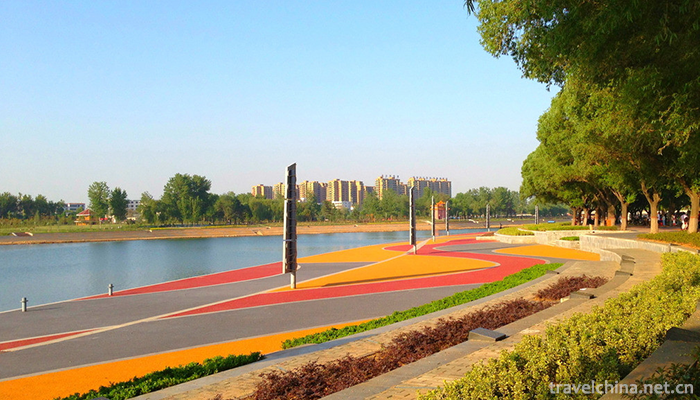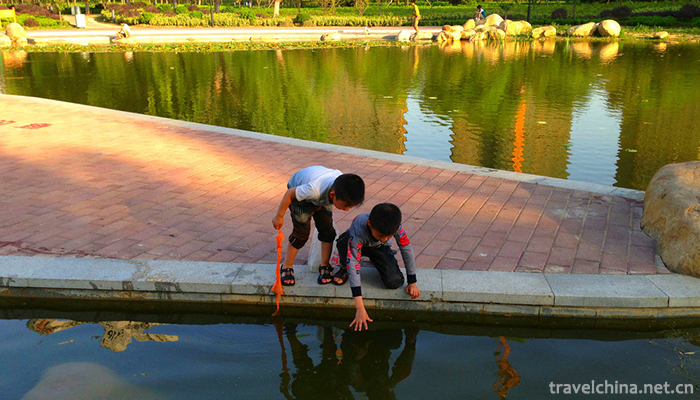Shali River Scenic Area
Shali River Scenic Spot, located in Luohe City, Henan Province, is built on the basis of Shali River and Lihe River. The total area of the scenic spot is 86 square kilometers. With the unique natural conditions and geographical advantages of Shali River, it has reached the relevant standards and requirements stipulated by the provincial water resources scenic spots, and has been appraised as "Henan Water Resources Scenic Spot".
In 2010, it was awarded National AAAA Tourist Scenic Spot.
Development history
In June 2010, Shalihe Scenic Spot was assessed as a national AAAA-level scenic spot with the approval of Henan Provincial Tourism Scenic Spot Quality Grade Assessment Committee.
geographical environment
Shali River Scenic Spot is rich in landscape elements, rich historical and cultural accumulation and rich flavor of human life. It is widely green along the riverbank with a vegetation coverage rate of more than 98%. It has built a theme park along the river with sightseeing avenues. Eight theme parks along the river are the core of the scenic spot, namely, Xiwan Morning Xixia, Fangfeng Yasong, Guhan Yuan, Liquan Evening, Haopu Happy. Qinghu paints autumn and Yufeng paintings. Constructed a fairyland of the world that "the city is reflected in the water, the water is in the green, and the people are in the middle of the painting".
Main attractions
Shali River Water Conservancy Scenic Spot is built on the basis of the two major water systems of Luohe City, Shahe River and Lihe River.
Shali River runs through the city centre of Luohe. On the basis of extensive public opinion, the government of Luohe Municipal Committee and Municipal Government has made the decision to develop Shali River and build the scenic corridor, leisure corridor, cultural corridor and ecological corridor along the river. It is a comprehensive project integrating urban flood control, garden greening, protection of drinking water source, cultural undertakings development, improvement of residential conditions and ecological environment management. From the west, the new 107 National Highway is 100 meters west, and from the east to the junction of Shahe and Beijing-Zhuhai Expressway. The area is about 86 square kilometers.
The total investment of the project is more than 2 billion yuan, which is implemented in three phases. The construction period is 3 to 5 years. The project was officially launched in November 2006. The main tasks of the project construction are: to spread green widely around the "two rivers", widen the water surface, build eight theme parks and sightseeing avenues along the rivers, intensify the transformation of both sides of the river, implement the project of "water diversion into the city", build a "water rhyme city", and realize the harmonious unity of "city, water, people, green and culture".
The eight theme parks along the river are the core of the scenic landscape belt along the Shali River. They are: Xiwan Chenxia (107 National Road to Jinggangshan Road Shahe Bridge), Fangfeng Yasong (Shahe Bridge to Songshan Road Shahe Bridge), Guangu Hanyuan (at the intersection of Shali River), Liquan Xizhao (Songshan Lihe Bridge to People's Road Lihe Bridge), Hapu Express (Taishan Road Bridge to Beijing-Guangzhou Railway Bridge), Luanqing (Beijing-Guangzhou Railway Bridge). Railway Bridge to Jinshan Road Bridge, Qingxiu Write Qiu (Jinshan Road Bridge to Yellow River Road Bridge), Xufeng Drawing (Yellow River Road Bridge to Dongzhuang Shahe Bridge).
The purpose of this paper is to construct a fairyland in which the city is reflected in the water, the water is in the green, and the people are swimming in the paintings through the eight theme parks covering the thick River culture, shipping culture, literary culture, wine culture, drama culture, farming culture, bridge culture, catering culture, folk culture, religious culture and red tourism culture of Luohe River.



0 Questions
Ask a Question
Your email address will not be published.